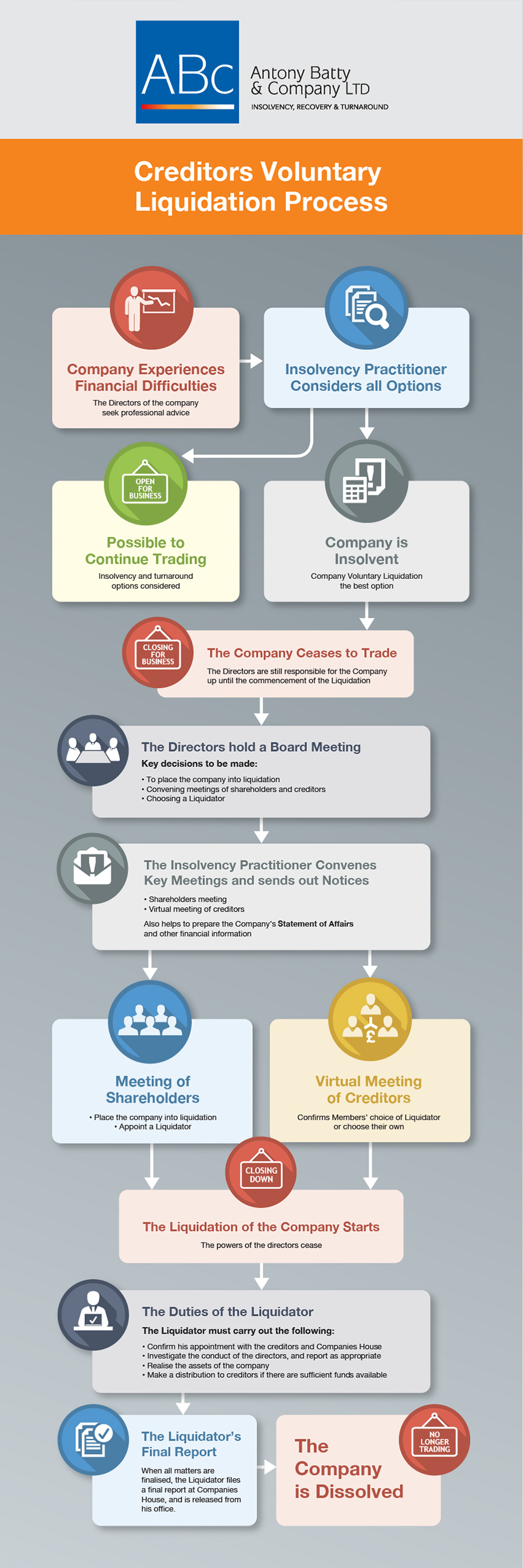A Creditors’ Voluntary Liquidation (CVL) is a procedure used to wind up an insolvent Company where the value of the assets of the Company are insufficient to pay all its debts and it in effect becomes insolvent. At the commencement of the process, the decision to proceed with a CVL – and therefore liquidate a Company – occurs where there is a general meeting of shareholders, (usually authorised at the company directors’ request), who then decide to put a Company into Liquidation because it is not able to pay its debts, the assets and liabilities being out of balance.
At the end of the process the Company is liquidated, the Registrar of Companies removing the Company from the Companies House register, it then being officially struck off.
Once under way, a CVL is under the effective control of the creditors (who normally hold a formal meeting of creditors), who can appoint a Liquidator of their choice. At this stage, the powers of the directors and shareholders are terminated.
Need help?
If your business is facing insolvency, the sooner you contact us, the more we can help.
What is a Creditors Voluntary Liquidation?
Tom O’Keeffe, Insolvency Administrator explains about Creditors Voluntary Liquidations
Did you know? It is possible for a director of a liquidated company to work as a director again in another company or a new company, providing that no wrong doing was found during the liquidation process and there was no director disqualification. Take a look at our 6 things for directors to do to avoid another liquidation article.
When is a CVL used?
A CVL is the most common way for directors and shareholders to deal voluntarily with their Company’s insolvency.
Ultimately it is the directors that commence the proceedings in a CVL. The directors formally resolve that the Company cannot continue to trade because of its debts, and they nominate a Licensed Insolvency Practitioner – as the Liquidator – who assists the directors in the preparation of a statement of affairs to be presented to the creditors.
Restructuring the Business should always be considered as a first option.
Before a Company reaches the liquidation stage, its financial health is usually already in a state of distress, due to cash flow problems, falling margins, the need to have extended creditor days, which often lead to higher interest payments, defaulting on bills, etc. Whilst in the financial distress stage, it is still possible to restructure and turn things around if help is called in quickly enough, well executed debt management plans often saving the day. Other . recovery options include a Company Administration or a Company Voluntary Arrangement (CVA).
However, if things do not improve, then distress turns into a crisis, and that is when the Company’s debts – the money that it owes to its creditors – are at a level which means that Liquidation is the only real option, the balance-sheet proving that there is no other choice. Our team will guide you through the whole process.
Take a look at a case study of a CVL where we were able to sell the business and assets of a company to another company, saving jobs in the process.

A quick guide to the CVL process

via Google Reviews
Liquidation FAQs
A Creditors’ Voluntary Liquidation (CVL) must follow the procedure set out in the Insolvency Act 1986 (as amended). When appointed as Liquidator, our Insolvency Practitioners will assist the Board of Directors with the preparation and administration at each stage, including drafting notices, minutes and other documents where appropriate, but the ultimate responsibility remains with the Board.
A quorate meeting of the Board of Directors will have to approve the issue of notices convening the members’ meeting and if necessary the creditors’ meeting as required by statute to place the Company into CVL, nominate someone to convene the decision procedure to appoint a Liquidator and state which Directors are to verify a statement of affairs on behalf of the Company by completing a statement of truth.
We will provide standard minutes that include resolutions that, among other matters, will approve our pre-appointment fees and appoint us to assist with the convening of the decision procedure to appoint a liquidator.
Notices have to be issued to members and creditors within statutory timescales convening a meeting of members to wind up the Company voluntarily and appoint a Liquidator. In addition, notices are required to convene a decision procedure where creditors appoint a Liquidator and authorise the payment of any outstanding pre-liquidation fees incurred in connection with preparing the Statement of Affairs and convening the decision procedure from the assets of the Company. Notices will need to be sent to all creditors on the same business day.
The Directors nominated by the meeting will be required to prepare a Statement of Affairs on behalf of the Company. Our Licensed Insolvency Practitioners will assist you in preparing a draft statement of affairs from information that the Board provides, but it remains the Board’s statement, and those who verify the accuracy of its contents by completing a statement of truth will be ultimately responsible for any false disclosure or omission.
The Statement of Affairs must be provided without delay as it must be sent to the creditors so that they receive it no later than the business day before the day that they make a decision as to who will be appointed Liquidator. It is the responsibility of the Directors, as those initiating the liquidation process and convening a Decision Procedure of the creditors to appoint a Liquidator, to ensure that this statutory timescale is adhered to, as failure to do so is an offence under the insolvency legislation that could lead to a fine being imposed.
The Director nominated to convene the decision procedure to appoint a Liquidator, will also be required to provide additional explanatory information in support of the Statement of Affairs, which will be sent to the creditors so that they receive it no later than the business day before the day that they make a decision as to who will be appointed Liquidator.
Although we will assist in preparing the explanatory information, it remains your responsibility as Directors to ensure that it is accurate. In addition, where a meeting of creditors is held, the nominated Chair may have to answer questions raised by creditors in response to any disclosure made in it.
A general meeting of the Company will be convened at which members will be required to pass a resolution placing the Company into voluntary liquidation and appointing a Liquidator.
After the Company meeting, the creditors have the opportunity to nominate Liquidators in place of the Liquidator appointed by the members, appoint a Committee to assist the Liquidator, and in the absence of a Committee, approve any pre-liquidation fees not already paid, where they are to be paid from asset realisations in the liquidation.
There are two ways the creditors can nominate a Liquidator.
First, by a Deemed Consent procedure, where the Liquidator appointed by the members will be automatically nominated by the creditors, unless sufficient creditors object.
Secondly by way of a Virtual Meeting, that is one where the participants are not present in the same location, but where they can communicate directly with one another and the chairman of the meeting. Antony Batty & Company LLP will advise the Board on the most appropriate way for the creditors to nominate a Liquidator. If a virtual meeting is held, one of the Directors will need to act as Chair of that meeting.
Whichever approach is taken, it is also possible for the creditors to requisition a physical meeting of creditors if the statutory minimum number of creditors in value, number, or as a percentage of total creditors, make a request in writing before the decision is made by the creditors as to who is to be Liquidator. One of the Directors will need to act as Chair of that meeting.
Where there is doubt over a prospective participant’s authority or entitlement to participate at a virtual or physical meeting, and/or over the amount for which a participant should vote, then it may be appropriate for the Chair of the meeting to consider obtaining independent assistance to determine the appropriate action to take.
Similarly, where a Deemed Consent procedure is used, then it may be appropriate for the Directors as conveners of the procedure to consider obtaining independent assistance to determine whether it is appropriate to allow, or refuse to allow, any objections. If that situation arises then Antony Batty & Company LLP will not be able to assist as we will not be independent given that one of our Insolvency Practitioners is seeking the appointment as Liquidator, but we will direct you to an appropriate firm of solicitors who will be able to provide such advice.
After the appointment of the Liquidator, the Liquidator is required to issue and advertise a variety of notices for the attention of the Registrar of Companies, the Secretary of State, other statutory bodies such as HM Revenue and Customs and the members and creditors generally.
After appointment the Liquidator will need to seek approval for the basis of his fees for acting as Liquidator. The basis of their fees will be approved by the Committee if one is appointed. If no Committee is appointed, then the Liquidator will seek approval from the creditors by seeking a decision from the creditors. Where a Virtual Meeting is held for the creditors to nominate Liquidators, the Liquidator may seek approval for the basis of his fees at that meeting, if no Committee is appointed.
Within the first three months following his appointment, the Liquidator is required to complete a confidential online report to the Secretary of State on the conduct of those who have been directors, or shadow directors, of the Company in the last 3 years.
The information contained in the online report could result in the Secretary of State taking action to disqualify one or more of the directors, or shadow directors, from managing a Company for a period of between 2 and 15 years.
By choosing a Liquidator, directors regain control of the situation through to liquidation. Once the decision is made to enter a CVL, the directors are free to choose their own Liquidator initially (although if the lenders creditors disagree with the choice, they can appoint a different Liquidator at the creditors’ meeting). The CVL process is then set in motion and it cannot be objected to by creditors.
In a CVL, the company also avoids being wound-up by creditors in an involuntary manner through a statutory demand, or winding up order, etc., through the courts and being forced into a compulsory liquidation (all claims against the company being dealt with), where the Official Receiver (a government official and officer of the Court) takes control.
If you have an outstanding debt, such as a Bounce Back Loan (for example) or are in arrears to HMRC, then a strike-off application will likely be rejected, meaning the only option is for a Creditors’ Voluntary Liquidation.
Pressure from unsecured creditors ceases, this alone making it one of the best debt solutions available. Once the formal liquidation process begins, all unsecured debt falls within the liquidation estate and any claims are made to the Liquidator. This is because once the CVL process starts, the responsibilities of the directors stop and all responsibility passes to the Liquidator who deals with all matters relating to the business assets of the Company going forward. The only exception to this would be any debts secured by personal guarantee.
Any current or future legal actions are defended by the Liquidator upon entering a CVL, thus removing that stress from directors. This covers County Court Judgements and Winding Up-Petitions,
A director can continue to be, or become, a director of other companies. This is even after a company they have been director of has gone into liquidation. We often find this is not widely known, with many directors fearing that liquidation will mean they might never work again. A caveat is that if the Liquidator uncovers evidence that the insolvency has been caused by a director not fulfilling their statutory duties, then that can trigger a director disqualification investigation by the Insolvency Service, which could result in a director disqualification period of up to 15 years, under the Company Directors Disqualification Act, 1986.
Leases can be cancelled. Once the liquidation process begins, the Liquidator may disclaim any property lease, all communication with any landlords being dealt with by the Liquidator.
Employees may be entitled to claim statutory redundancy entitlements. Although all employees are made redundant when a company enters a CVL, they can claim statutory redundancy entitlements and other payments even though the insolvent Company is unable to pay them their entitlements, as such funds come from a Government backed Redundancy Fund that covers all contractual employee claims against the Company. Take a look at this article for more details on claiming statutory redundancy.
Directors can continue to trade through a different company. It is possible to liquidate a company and continue to trade the business through a newly registered or existing company. This is called a pre-pack liquidation, and there are procedural hoops that need to be addressed and assets valued and paid for if there is a continuance of trade or re-trading of some or all of the business. Professional advice must be taken and Court leave may need to be sought to use the same or a similar name.
There are 3 main scenarios where this is possible. Firstly, you can apply to the Court for permission to do so, but this must be done within 7 days of the liquidation. Secondly, it is possible to reuse the name if you buy the business from the liquidator, but creditors must be informed and an advertisement placed in the Gazette. Thirdly, if the company has used the name for at least 12 months before the liquidation took place, you may be able to continue to use the name as long as it wasn’t a dormant company during this time.
Outside of these 3 reasons, the answer is no and there are serious repercussions for doing so. This whole area is dealt with in section 217 of the Insolvency Act 1986.




